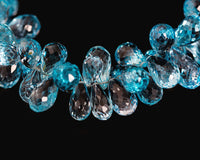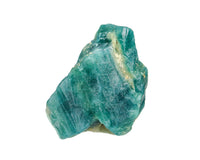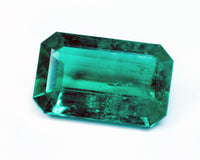- 1. Libyan Desert Glass
- 2. Origin of Libyan Desert Glass
- 3. The History of Libyan Desert Glass
- 4. Chemical and Physical Properties
- 5. The Healing Properties of Libyan Desert Glass
- 6. The Magical Properties of Libyan Desert Glass
- 7. Libyan Desert Glass from KenKenGems
Libyan Desert Glass
Born in the perilous and hostile Eastern Great Sand Sea (otherwise known as The Libyan Desert), this mineral has been tantalizing the human eye since time immemorial. It became the jewel of pharaohs in Ancient Egypt. To find a worthy embellishment for Tutankhamun’s necklace, his subjects had to walk more than 2000 kilometers across scorched dunes. The heart of the wilderness gave us Libyan Desert Glass, a mineral older than human civilization. Its origin is shrouded in mystery, and the fact that it is one of the rarest minerals on Earth - gemologists estimate its reserves at 1,400 tons - makes it catnip for gem connoisseurs.

Origin of Libyan Desert Glass
For more than 200 years, scientists have been debating over the origin of this natural glass. The most plausible explanation is the explosion of a meteorite in the atmosphere. Black inclusions found in several specimens of Libyan Desert Glass support this theory. Not only do they contain the elements characteristic of meteorites (iron, nickel, and cobalt) but also iridium, which concentrations are atypical for the earth's crust.
This is how scientists describe the possible origin of the Libyan Desert Glass. 28 million years ago, a meteorite featuring a diameter of 30 meters burst into the earth's atmosphere. When its dense layers exploded, they produced an immense amount of thermal energy. Hot air reaching up to 2000 C hit the earth's surface and melted desert sand over an area of hundreds of square kilometers. After cooling, the sand turned into glass. At first, the fragments of desert glass had an irregular shape and a rough surface. Over time, the wind and grains of sand polished the surface just like a sea wave grinds bottle shards.

The History of Libyan Desert Glass
People discovered golden glass thousands of years ago. The evidence for this is the finds of glass spearheads, axes, and other tools used among the dwellers of the Libyan Desert. They split smooth stones to get sharp edges for their primitive tools. Along with that, ancient people could not ignore the beauty of desert gems. The scarab-shaped centerpiece of Tutankhamun's necklace created around 1300 BC bears a fragment of the Libyan Desert Glass.
For some reason, Libyan glass has gone off the radar until the early 20th century. In 1932, Sir Robert Clayton, when looking for the legendary Lost Oasis of Zerzura, stumbled upon yellow glass stones. Scientists had speculated about their origin for quite some time until Italian scientists resolved an enigma of its origin in 1999.

https://store.kenkengems.com/collections/libyan-glass
Chemical and Physical Properties
The Libyan mineral is the purest natural glass. Its chemical composition is 98% silicon dioxide and 2% is the dust of presumably extraterrestrial origin. The material belongs to an extensive class of tektites, i.e. minerals formed as a result of meteorite impacts.
Libyan Desert Glass is a popular inlay for medallions, amulets, bracelets, and other pieces of jewelry. A meteorite-born stone is hard enough (5.0-6.0 on the Mohs scale) to withstand mechanical or chemical damage. It tolerates any temperature extremes; otherwise, the heat of the Libyan Desert would simply destroy it. The mineral can be easily polished and cut. It can take any shape you like, although it’s common to use its natural irregular shape to emphasize its extraterrestrial origin.
Thanks to its attractive appearance, the impact stone is an excellent choice for jewelry. Some specimens are absolutely clear, and others contain a beautiful milky mist. Individual specimens show a wide range of pale yellow colors from almost white to honey. For this reason, it is romantically dubbed the “Sun of the Libyan Desert”.
Clear stones have the highest worth among their peers. On the other hand, different kinds of inclusions don’t really impact the value of the mineral. Conversely, they may increase it price dramatically. Black or brown bands and swirls found inside Libyan Glass are none other than the remnants of the meteorite.
The Healing Properties of Libyan Desert Glass
Libyan Desert Glass is believed to reduce the negative effects of stress. It helps steady the nerves and get sound sleep. Amulets and talismans featuring this rare material are able to give peace of mind and save from nightmares. Along with that, the mineral facilitates the treatment of respiratory diseases. It also has a beneficial effect on metabolic processes and kidney functioning. Lithotherapy experts prescribe Libyan Desert Glass to people who have low blood pressure, diabetes, and eating disorders.

The Magical Properties of Libyan Desert Glass
The ancients used Libyan glass not only for tools and ornaments but also for their rituals. They believed that magic stones would help them establish contact with the world of spirits. On top of that, gems became indispensable attributes of healing, rainmaking, funeral, and witchcraft rituals.
Ancient people felt that Libyan glass is a gift of the universe. It came as no surprise that they utilized it to ‘travel’ through time and space. Modern shamans use it for the same purpose. You can take advantage of the natural glass even if you know nothing about shamanisms and mysterious rituals. You can count on it to strengthen your karma and improve your understanding of the world around you. If you want to avoid mistakes and make good decisions, Libyan Desert Glass will come in handy. It also becomes an excellent talisman to protect against malevolent gazes.
Libyan desert glass patronizes Aries and Cancer. The latter can benefit from the stone to correct their past mistakes. It brings good luck to Cancers and helps in their creative endeavors.

Libyan Desert Glass from KenKenGems
Alluring and extremely rare, Libyan Desert Glass is the star of our collection. We carefully polish and cut these golden stones to preserve and enhance their innate beauty. Every piece we supply boasts a unique shape, color, and internal structure meaning you’ll become an owner of a one-of-a-kind jewel. KenKenGems delivers uncut and undrilled nuggets, cabochons, and freeform cuts for sale. Along with that, we produce wear-ready pieces such as pendants in silver settings and bead bracelets. Whatever product you choose, we guarantee a fair price, authenticity, and unparalleled quality.





